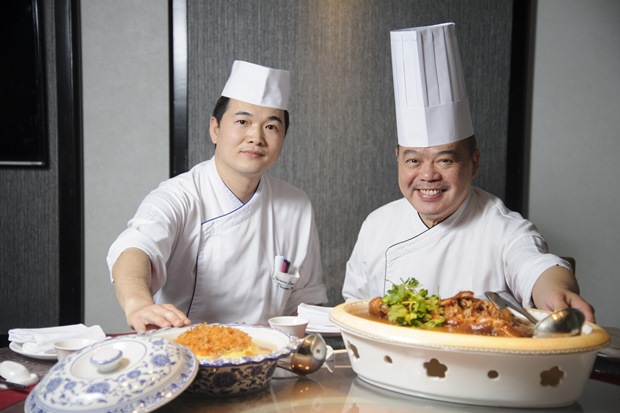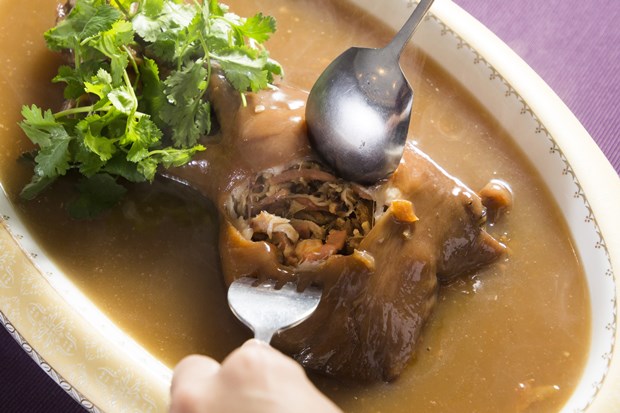The Ultimate in Taiwanese Cuisine
‘Rich Man’s Dishes’ Returning to the Table

Source:Ming-Tang Huang
Other than the “little eats” snack food for which Tainan is renowned throughout Taiwan and beyond, in generations past the private banquet food served in the homes of the area’s wealthy represented the pinnacle of fine cuisine. Now this ‘rich man’s fare’ is making a comeback.
Views
‘Rich Man’s Dishes’ Returning to the Table
By Sunny Wuweb only
Cuisine is a consistent thread running through Taiwanese history. Fine cuisine researcher Huang Wan-ling (黃婉玲), a dedicated proponent of the movement to restore Taiwanese cuisine and a consultant on the hit film Zone Pro Site, relates that Taiwanese cuisine can generally be divided into several categories, namely “rich man’s cuisine (阿舍菜), restaurant cuisine, wedding cuisine, banquet-style and family-style cuisine.” Based on the foundation of Chinese food from the mainland, Taiwanese cuisine makes just the right modifications to the flavor and techniques used in the preparation of each dish, while adding personal touches. Taiwanese cuisine can be characterized as “opulent,” especially in the case of “rich man’s” dishes.
Huang relates that classic Taiwanese cuisine goes lighter on flavoring and condiments such as salt, sugar, and oil, utilizing the ingredients themselves instead to bring out the flavor.
In current terms, this is called attention to “slow eating and healthy living.” This cuisine lets the essential flavor of each ingredient “Authentic Taiwanese cuisine is sweet, not sugary,” Huang stresses.
Chefs had to be technically sophisticated and have many tricks up their sleeves to become the house chef in a rich family’s home back in the day. Huang notes that one distinguishing aspect of ‘rich man’s cuisine’ is that each dish has an element of being a secret that has been passed down. Another aspect that sets it most apart from restaurant fare is the attention to detail; this goes beyond polished technique to include the expression of the richness and cultural undertones of the various flavors.
Low-profile Fare for the Wealthy
Back in the early days of Taiwan’s settlement by Chinese, rich people were often referred to with “A-She” appended to their name, an honorific akin to “esquire” or “master.” “A-She” was never used in reference to oneself; rather, it was a term used by others as a sign of validation and reverence, as many prominent families were genteel and cultured. Although not holding an official position, a wealthy figure would often readily look after the lives of commoners and take on social responsibility.
A Tainan native and descendant of “Tainan’s first family” on her mother’s side, the Liu family, Huang has sampled fine cuisine of every description since childhood, reveling in listening to the stories of family elders. Huang relates that wealthy families tended to be conservative and preferred to keep a low profile. Accordingly, only close friends and relations would receive invitations to dine at their homes. For social occasions, a restaurant would suffice. (Read: Let’s Eat, the Taiwan ‘Way’)
Huang cites the example of the famous Lin family of Taipei, whose homestead included a grand parlor for entertaining guests and receiving visitors. In contrast, she notes, important Tainan families did not accommodate such a space because “members of the wealthy class were eccentric and proud. To them, their home belonged strictly to them, and bringing random friends home with them was not looked upon kindly. The average person had absolutely no opportunity to taste rich man’s dishes. Accordingly, the dishes “were not easily passed along, and people were reluctant to give them out,” notes Huang.
“Rich man’s cuisine” is not the name of a dish, but was the name of the food enjoyed by the wealthy. Stephen Lo, executive chef at the Tainan Silks Palace Hotel, notes that the prohibitive cost of ingredients and tremendous effort of preparation meant that only the wealthiest people had the means and leisure to enjoy rich man’s food, which was a big production. On the third and fourth days of the coming Chinese New Year, Lo’s hotel will roll out a special New Year’s Spring luncheon, featuring 16 courses and 27 traditional dishes, including such delicacies as stuffed chicken, and pig’s knuckles with shark fin soup, to recreate the refined culinary culture of Tainan’s glory days as Taiwan’s capital.
“This fare is torturous for chefs,” says Lo with humor, as nothing is too extravagant for rich man’s cuisine. For instance, the house specialty, “stacked dishes,” piles ingredients for two divergent flavors into one dish, testing the chef’s culinary skill with several layers of flavor along with an impressive visual presentation.

Stacked Dishes Test Skills
Plate arrangements that appear somewhat haphazard are actually quite elaborately wrought, as is the case with the pig’s knuckle and shark’s fin dish.
As Pan Chin-liang, assistant chef for Chinese cuisine at the Tainan Silks Palace Hotel, relates, rich people want to have pig’s knuckles but do not want the bone, yet require them to appear intact. This necessitates the manual removal of all the bone from each foot. Yet pig’s feet combine tough sinew and tender skin, and Pan had to practice on over a hundred pig’s feet before he could complete his first successful culinary surgery. Back in the day, the master chef would bring the extracted bone out to the table for the wealthy diners to examine. “This dish is highly demanding of the chef’s skills with the knife,” he adds.
The filleted pig’s feet are marinated, and filling ingredients such as bamboo shoots, mushrooms, ham, and shrimp are stir-fried together prior to placing them into the pig’s feet before stitching them closed with a needle. Next, it is steamed at high heat, and splashed with broth flavored with fat choy. As Pan Chin-liang describes it, when brought out to the table, the dish is a tender braised pig’s knuckle with an al dente mouth feel on the outside, from which springs forth piping hot shark’s fin soup when sliced open. Together with the fresh, sweet filling, it creates a soup with just the right body.
Another marquee dish that emphasizes visual enjoyment and flavorful broth is Chrysanthemum Scallop Soup. First, fresh bamboo mushrooms, pork, egg skin, and scallops are finely sliced and fried together, with the egg skin lining the inside of the bowl. Just before the dish is brought out, the bowl is inverted with the ingredients inside, and the thin egg covering is sliced into triangular flaps that, when opened outward, form a petal-like shape. Finally, the broth is poured in the center. When served, the steam rising from the blossom-like shape creates a lovely, elegant picture.
Chrysanthemum Scallop Soup puts the chef’s skills to the test. As Pan relates, “If you haven’t put in enough work to get your technique right, you won’t be able to fry egg skin properly, which will keep you from showing the beauty of this dish.”
Multiple Schools and Traditions
Time marches on, and the Nationalist government’s land reform program, the main pillar of which was a mandatory rental limit of 37.5 percent of the year’s harvest for arable land, was a significant blow to the economic might of the wealthy. As the wealthy tightened their purse strings, many family chefs lost their jobs and returned home, where they cooked for banquets. In this way, “rich man’s fare” slowly made its way into the general population. However, according to Huang Wan-ling, family chefs adhered to a sort of “code of silence,” as “letting a recipe get out was seen as disrespectful to the old boss. Not to mention that according to the ethics of the old days, it was forbidden to do so,” she asserts. This explains the rarity of rich man’s cuisine today.
Rich man’s cuisine was divided into different schools, each with its own characteristics, says Huang. The Innovation School incorporated Western elements and flavorings like bread and milk; the Fujian School, to which her family belonged, broke through the geographical boundaries of mainland Chinese cuisine and modified it in individual ways, with added attention to refined craftsmanship; and the Japanese School featured lighter flavors and extensive use of miso.
Translated from the Chinese article by David Toman
Additional Reading
♦ Let’s Eat, the Taiwan ‘Way’
♦ Rethinking Taiwan’s Food Safety System: Is Your Kitchen Really Safe?
♦ Land Dyke Feminist Family Farm: Women Create Farming Community









